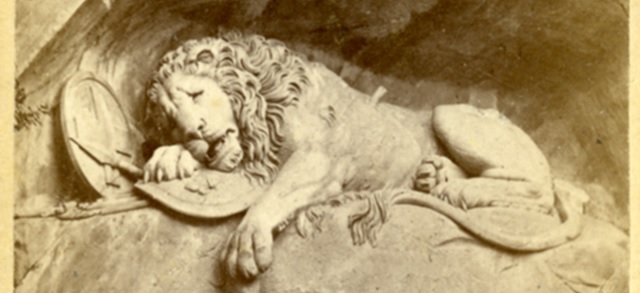
Monuments Class Projects
Architect/Sculptor of Monument
Baron Carlo Marochetti (1805-1867)
Preview

Medium
photograph, carte-de-viste
Keywords
King Richard I of England, Richard the Lionheart, Richard I Coeur de Lion, Equestrian Statue, Baron Carlo Marochetti, Victorian Sculpture, Romantic Nationalism, Palace of Westminster, Old Palace Yard, London, British Monarchy, Crusades and Medieval Kingship, 19th-Century Public Art, Bronze Equestrian Monument, Neo-Gothic Architecture, Westminster Abbey, London, Historic Statues of London, Royal Symbols in Art, National Identity through Sculpture, Sword-Raising War Iconography
Physical Dimensions
4 in x 2.5 in"
Date of Publication
c. 1867-1900
Name of Monument
Richard Coeur de Lion
Date of Creation of Monument
10-1856
Date of Completion or Dedication of Monument
3-1867
City of Monument
London
Location within City
Old Palace Yard outside the Palace of Westminster
Country of Monument
England
Description
This bronze equestrian statue of King Richard I of England, also known as Richard the Lionheart, is located in the Old Palace Yard outside the Houses of Parliament in London. The statue was created by Baron Carlo Marochetti and first exhibited at the Great Exhibition in 1851. It was permanently installed at the Palace of Westminster in 1860. It depicts King Richard I in medieval armor atop a powerful warhorse, with his sword raised high in a gesture of defiance and leadership. In 1867 bronze reliefs were added to the sides.
School of Art/Architecture
Victorian Neo-Gothic / Romantic Sculpture
Digital Date
Spring 4-2025



Comments
Outside the Houses of Parliament, or the Palace of Westminster, in London stands a powerful figure cast in bronze—King Richard I of England (1157–1199). Known as “the Lionheart” for his boldness in battle and commanding presence during the Third Crusade (1189–1192), Richard’s reputation has long been the subject of both admiration and debate. His equestrian statue, created by Baron Carlo Marochetti (1805–1867) and installed in 1860, reflects a Romantic vision of medieval kingship idealized by Victorian Britain. The monument not only celebrates a monarch but also conveys the values, aesthetics, and historical interests of the Victorian period.
Although Richard I was born into the powerful Plantagenet dynasty and held the English crown, he spent very little time on English soil, less than a year in total. Most of his reign was consumed by warfare abroad. Yet during the 19th century, when Britain’s empire was expanding and interest in medieval romanticism was at a high, Richard was recast in the public imagination as a heroic symbol of national strength and chivalry. In many ways, the Richard remembered through this monument is less the man who ruled and more the myth that Victorian Britain needed.
The statue had its early debut at The Great Exhibition of 1851 in Hyde Park, a landmark event celebrating technological and artistic achievements. The model received praise, and the artist, Marochetti, a popular sculptor of French-Italian descent, was asked to create a permanent version. In 1860, the finished statue was placed in Old Palace Yard, just outside Westminster Hall. This location, at the seat of British government and across the street from Westminster Abbey, carries immense historical and political weight. It places the image of Richard within a landscape of national identity and power, visually linking the past and the present.
Stylistically, the statue draws from the Gothic Revival movement, which was flourishing at the time. The monument captures Richard in full medieval armor atop a muscular horse, his right arm raised, brandishing a sword in a commanding gesture. There is an air of drama in the way Marochetti depicts him: idealized, noble, and almost theatrical. The inscription, which reads "RICHARD I COEUR DE LION", reinforces this romanticized identity, choosing to focus on his symbolic qualities rather than his complex legacy.
The design of the statue fits neatly into the broader architecture of the Palace of Westminster, which had been rebuilt in the Gothic Revival style after a fire destroyed much of the original structure in 1834. The new buildings, designed by Charles Barry and Augustus Pugin, embraced medieval motifs and historical references. Marochetti’s statue was not just an isolated tribute—it was part of a national story being retold in stone and metal across London’s most significant political and ceremonial spaces.
Throughout its history, the statue has witnessed moments of change. One of the most visible marks came during the Second World War, when a nearby bomb explosion during the Blitz (1940–1941) damaged the sculpture. The sword was bent and parts of the pedestal were pitted with shrapnel, though these scars were never fully repaired. Today, they serve as quiet witnesses to the resilience of the city and its people.
Even as historical scholarship has become more critical of Richard’s rule, highlighting the heavy taxation, his long absences, and political negligence, the statue remains unchanged. It continues to stand in Old Palace Yard, silently projecting a version of the past shaped more by 19th-century imagination than medieval reality. Its persistence speaks to how monuments shape collective memory, often glossing over complexity in favor of clarity and heroism.
The statue of Richard the Lionheart is more than just a tribute to a crusading king—it is a reflection of the era that produced it. Its placement, design, and symbolism tell us as much about Victorian Britain as they do about the 12th century. Whether viewed as an artwork, a political statement, or a piece of historical theater, the monument invites ongoing reflection about how we remember history, and why.